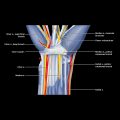Developmental Hip Dysplasia
KEY FACTS
Imaging
 Type Ia = mature hip, angular bony promontory, α > 60°, β < 55°
Type Ia = mature hip, angular bony promontory, α > 60°, β < 55°
 Type Ib = mature hip, roundish bony promontory, α > 60°, β < 55°
Type Ib = mature hip, roundish bony promontory, α > 60°, β < 55°
 Type IIa = physiologic immaturity < 3 months, α = 50-60°, β = 55-77°
Type IIa = physiologic immaturity < 3 months, α = 50-60°, β = 55-77°
 Type IIb = immaturity > 3 months, α = 50-60°, β = 55-77°
Type IIb = immaturity > 3 months, α = 50-60°, β = 55-77°
 Type IIc = critical hip, subluxation, α = 43-49°, β > 77°
Type IIc = critical hip, subluxation, α = 43-49°, β > 77°
 Type III = dislocated hip, α < 43°
Type III = dislocated hip, α < 43°
 Type IV = dislocated hip, inverted labrum, α < 43°
Type IV = dislocated hip, inverted labrum, α < 43°
IMAGING
General Features
Ultrasonographic Findings
 Coronal (“egg in spoon”) view
Coronal (“egg in spoon”) view
 Transverse (“ice cream cone”) view
Transverse (“ice cream cone”) view
 3 lines drawn on coronal view to assess acetabular morphology
3 lines drawn on coronal view to assess acetabular morphology
 Modified Graf staging
Modified Graf staging
 Attempt to displace femoral head from acetabulum during real-time imaging
Attempt to displace femoral head from acetabulum during real-time imaging
 Lack of relaxation by infant can limit acquisition of optimal stress view and can produce false-negative examination
Lack of relaxation by infant can limit acquisition of optimal stress view and can produce false-negative examination
 Acetabular bony coverage
Acetabular bony coverage
![]()
Stay updated, free articles. Join our Telegram channel

Full access? Get Clinical Tree






 , cartilaginous acetabular roof
, cartilaginous acetabular roof  , acetabular labrum
, acetabular labrum  , triradiate cartilage
, triradiate cartilage  , ischium
, ischium  , and ossified femoral metaphysis
, and ossified femoral metaphysis  .
.
 , acetabular labrum
, acetabular labrum  , femoral metaphysis
, femoral metaphysis  , and gluteal muscle are shown.
, and gluteal muscle are shown.
 , acetabular roof
, acetabular roof  , between the acetabular promontory and the tip of acetabular labrum
, between the acetabular promontory and the tip of acetabular labrum  , and the α and β angles formed by the intersection of these lines.
, and the α and β angles formed by the intersection of these lines.
 .
.











